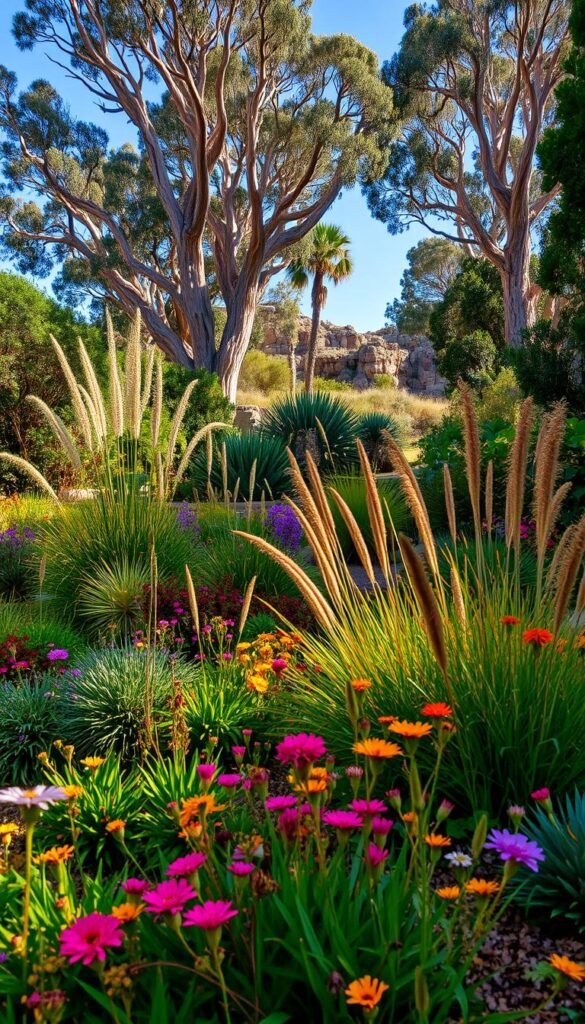Modern outdoor spaces are evolving to reflect both style and environmental awareness. Across continents, homeowners are rethinking traditional approaches to create sustainable, visually striking landscapes that thrive with minimal effort. This shift mirrors principles found in drought-tolerant gardening strategies, where smart plant choices become the foundation of lasting beauty.
By focusing on locally adapted flora, you can craft spaces that naturally resist pests and weather fluctuations. These selections often need up to 60% less water than non-native species, letting you spend more time enjoying your yard than maintaining it. Imagine vibrant blooms that attract butterflies and birds while requiring only seasonal care.
The true magic lies in balancing artistic vision with ecological responsibility. Thoughtful layouts might feature textured succulents beside flowering shrubs, creating depth and movement. Such arrangements not only elevate your property’s appeal but also support regional ecosystems through careful species selection.
As seasons change, your space transforms into a living showcase of natural patterns and colors. From silver-green foliage that shimmers in sunlight to bursts of seasonal wildflowers, every element works in harmony. This approach celebrates nature’s rhythm while delivering practical benefits for modern lifestyles.
Innovating with Native Australian Flora
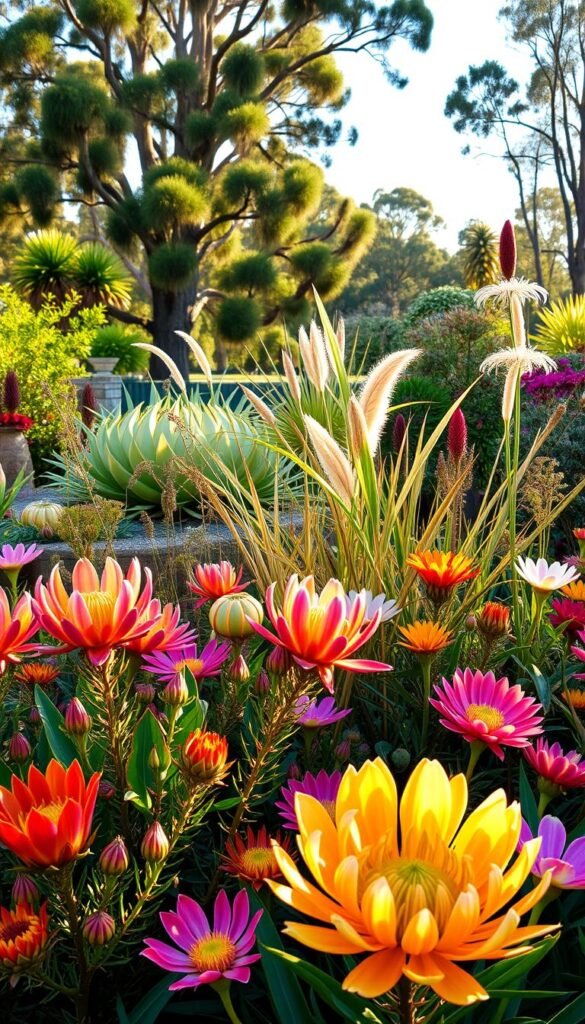
Contemporary landscapes are witnessing a botanical revolution as local species take center stage. Designers now work with an unprecedented selection of drought-resistant varieties that adapt effortlessly to different settings. Whether you’re crafting structured layouts or cottage-style landscapes, there’s a perfect match waiting to thrive in your space.
Diverse Plant Varieties for Every Setting
Grevillea ‘Robyn Gordon’ exemplifies this versatility with its spider-like flowers and leathery leaves. This superstar attracts honeyeaters while needing just occasional pruning. Other options range from groundcovers with silver-toned foliage to towering gum trees – all sharing natural resilience to local pests and weather patterns.
| Species | Height | Key Feature | Bloom Season |
|---|---|---|---|
| Kangaroo Paw | 2-4 ft | Velvety flowers | Spring-Summer |
| Bottlebrush | 6-15 ft | Bird-attracting blooms | Year-round |
| Grass Tree | 3-20 ft | Architectural form | Summer |
Seasonal Color Transformations
Strategic plant combinations create ever-changing displays. Waratahs erupt in crimson during spring, while golden wattles brighten winter months. Many species offer multi-season interest – flowering gums provide nectar-rich blossoms followed by decorative seed pods.
This approach reduces upkeep while maximizing visual rewards. You’ll spend less time watering and more moments enjoying nature’s self-renewing artwork right outside your door.
Embracing Sustainable Landscaping Practices
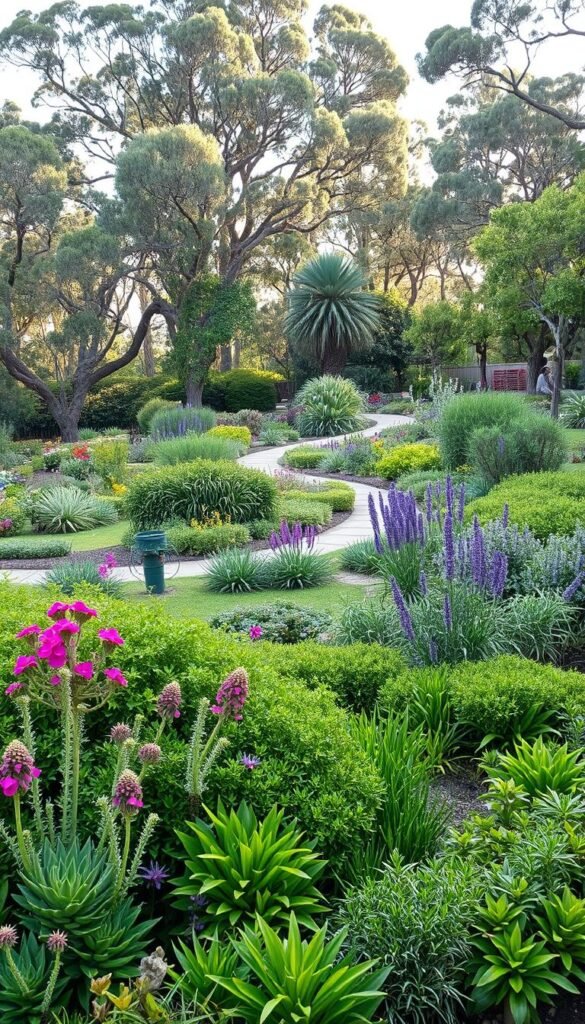
What if your yard could actively protect the environment while looking stunning? Modern landscape design now blends practicality with planet-friendly solutions. By focusing on resource efficiency, you create spaces that give back to nature rather than drain it.
Smart Water Management Systems
Start by rethinking water use with drip irrigation that targets plant roots directly. Pair this with permeable pavers that let rainwater seep into the soil naturally. Many homeowners add rainwater tanks to capture runoff from roofs – these systems can reduce outdoor water needs by up to 40%.
Earth-Friendly Construction Choices
Swap concrete for locally quarried sandstone in the Blue Mountains region. Fallen eucalyptus logs make perfect rustic edging, while recycled bricks create charming pathways. “Choosing regional materials cuts transportation emissions by 60% compared to imported options,” notes a recent sustainability study.
Complete your eco-upgrade with solar path lights that charge by day. These choices don’t just lower bills – they create habitats for creatures that support local ecosystems. Even stormwater becomes an asset when directed through gravel-filled trenches that filter pollutants naturally.
Every decision shapes a space that thrives with minimal intervention. From drought-ready plants to energy-efficient lighting, your yard becomes a testament to thoughtful sustainability. The result? A living system that adapts gracefully to seasonal changes while conserving precious resources.
Low Maintenance Elegance for Your Outdoor Space
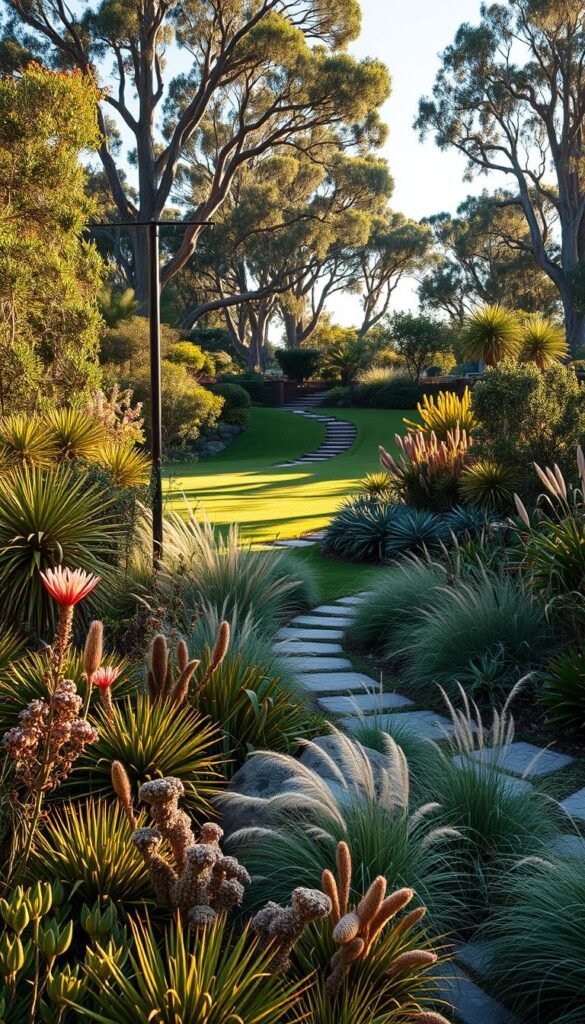
Transform your yard into a vibrant retreat that practically cares for itself. Busy homeowners are swapping fussy lawns for naturalistic planting styles that celebrate effortless charm. This approach works beautifully whether you’re crafting a sprawling backyard oasis or optimizing space on urban balconies.
Drought-Tolerant Plant Selections
Choose species like kangaroo paw or silver-leaved groundcovers that laugh at dry spells. These champions store moisture in their foliage, needing rainfall alone in most regions. You’ll enjoy year-round texture without weekly watering marathons.
Smart Irrigation and Minimal Upkeep
Pair resilient plants with drip systems that deliver hydration straight to roots. Rain sensors can pause watering after storms, while mulch layers keep soil moist. “Modern tech lets us mimic natural rainfall patterns perfectly,” explains a landscape design expert.
Say goodbye to endless pruning – native shrubs grow at slower paces suited to local conditions. Your weekends become free for lounging under shade trees rather than wrestling with shears. It’s sustainability made simple, with beauty that deepens each season.
Creating Inviting Outdoor Living Spaces
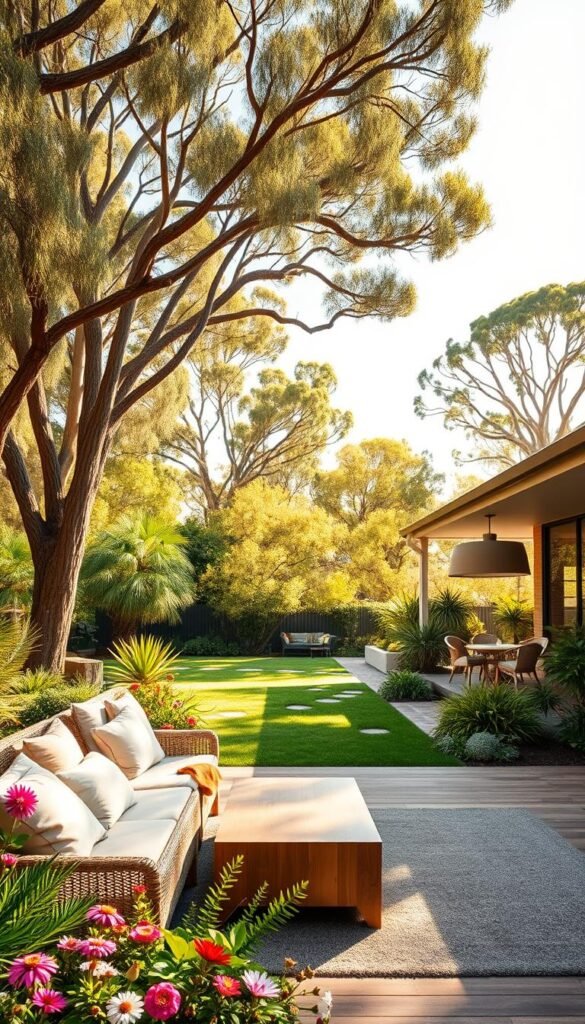
Your backyard can become an extension of your home’s comfort with smart layout choices. Thoughtful arrangements merge indoor convenience with nature’s charm, letting you host dinners under the stars or enjoy morning coffee surrounded by birdsong.
Integrated Patios, Decks, and Pergolas
Durable materials like composite decking or natural stone create versatile zones for daily use. These structures work harder than you might think:
| Feature | Best Use | Maintenance |
|---|---|---|
| Flagstone Patio | Dining areas | Annual sealing |
| Wooden Deck | Lounging space | Biannual staining |
| Steel Pergola | Shaded retreat | None |
Position seating areas near trees for natural cooling. Climbing plants on pergolas add privacy while letting breezes through.
Cozy Fire Pits and Natural Seating Areas
Gathered around flickering flames, you’ll appreciate how stone benches retain daytime warmth. Built-in seating with weather-resistant cushions turns unused corners into conversation hubs. For cooler months, radiant heat lamps extend outdoor time without high energy costs.
Outdoor kitchens with prep stations simplify entertaining. Keep essentials like herbs nearby – rosemary thrives in sunny spots and seasons grilled dishes perfectly. Your living space grows without costly renovations when you work with existing landscapes.
Material Choices that Blend with Nature
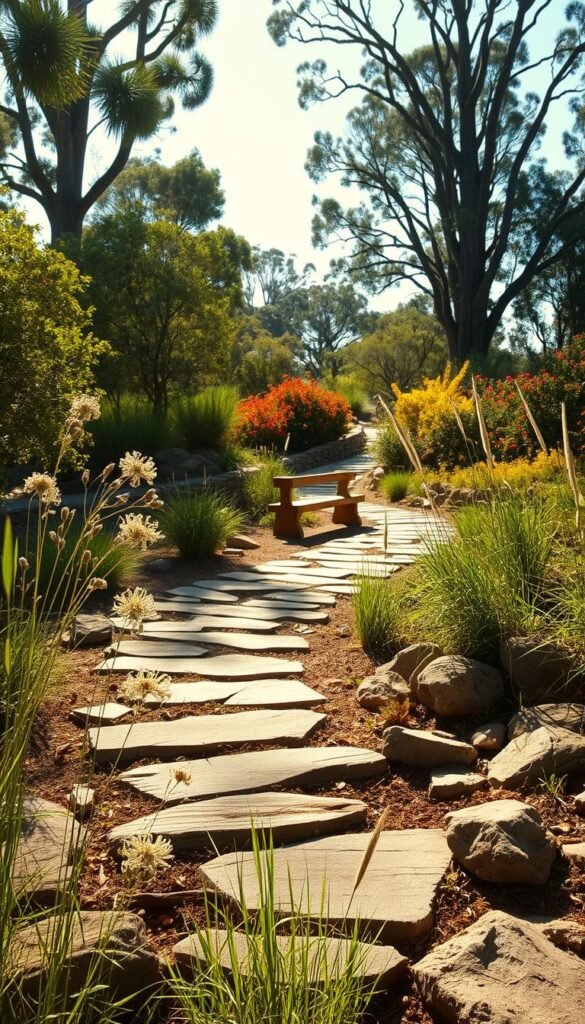
The right materials can make your outdoor space feel like a natural extension of the surrounding environment. Rusted steel and weathered timber gain character over time, mirroring the earthy tones of wild terrain. These choices reduce waste while creating textures that harmonize with local flora.
Opt for reclaimed elements that tell stories through their imperfections. Salvaged bricks become stepping stones, while repurposed railroad ties form rustic retaining walls. These materials require no chemical treatments – their weathered surfaces naturally resist rot and pests.
| Material | Key Benefit | Best Use | Regional Match |
|---|---|---|---|
| Rusted Steel | Develops protective patina | Edging/water features | Mountain regions |
| Sandstone | Natural cooling properties | Pathways | Blue Mountains |
| Recycled Timber | Prevents deforestation | Decking | Coastal areas |
In areas like the Blue Mountains, locally quarried stone blends perfectly with native vegetation. “Sandstone’s warm hues mirror the cliffs at sunset,” notes a landscape architect from the region. This connection to place strengthens your sense of belonging to the land.
Choose elements that evolve gracefully alongside your plants. Iron develops rich rust tones, while silvered wood echoes gum tree bark. Your space becomes a living canvas where human craftsmanship celebrates natural beauty without overpowering it.
Minimalistic Aesthetics with Maximum Impact
Simplicity becomes powerful when every element serves a purpose. Modern garden design thrives on intentional choices that highlight form over excess. This approach lets textures and shapes command attention while maintaining easy upkeep.
Purposeful Planting and Sculptural Elements
Choose plants that double as living art. Grass trees with spiky silhouettes or succulents with rosette patterns create focal points without clutter. Pair them with smooth river stones or weathered timber benches for contrast.
Focus on foliage variations rather than flower counts. Silver-blue leaves of coastal rosemary add cool tones, while burgundy flax lilies inject drama. This strategy ensures year-round interest even when blooms fade.
Clean Lines and Open, Balanced Spaces
Define areas with geometric planters or low retaining walls. Leave breathing room between features – negative space makes each element pop. A single specimen tree framed by gravel becomes a striking statement.
Limit color palettes to three main hues for cohesion. Warm greys, olive greens, and terracotta tones let natural beauty take center stage. This restraint creates calm spaces perfect for homeowners seeking refuge from busy schedules.
Incorporate modern touches like corten steel edging or circular water features. These elements complement native plants while supporting structured layouts. The result? Gardens that feel both curated and effortlessly harmonious.
Australian Garden Design: Embracing Native Plant Beauty in Your Landscape
Crafting outdoor spaces that honor nature’s wisdom creates living environments where beauty and responsibility coexist. By blending local plants with thoughtful design, you forge spaces that nurture both people and wildlife. Every choice—from drought-smart species to recycled materials—builds resilience while reducing your environmental footprint.
These landscapes thrive through seasonal changes, offering evolving textures and colors. You’ll discover how strategic layouts with native varieties attract pollinators while needing minimal care. It’s about creating harmony between human creativity and ecological balance.
The best part? Your garden becomes a personal sanctuary that actively supports regional ecosystems. Whether through rainwater harvesting or solar lighting, each sustainable touch amplifies your impact. You’re not just planting—you’re participating in a movement that values resourcefulness as much as aesthetics.
Ready to reimagine your yard? Start small with clusters of flowering shrubs or a gravel pathway. As your space matures, it’ll reflect the unique character of your local landscape while conserving water and energy. This approach proves that stunning design and environmental stewardship grow beautifully together.

